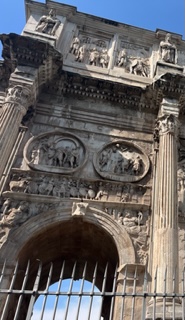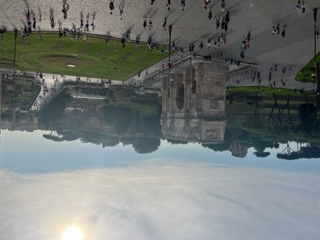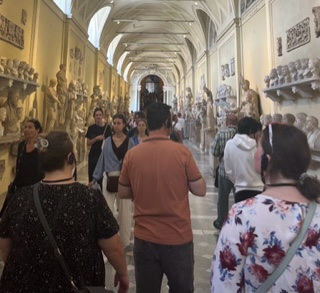The History of Christianity in Rome
- lherinckx
- Jun 6, 2023
- 4 min read
By Lauren Herinckx
When visiting Rome, one of the top places for people to visit is not actually Italy, but another country entirely: Vatican City. This, the smallest country in the world, is entirely surrounded by Rome. Vatican City’s history extends much further back than its independence, having only become a country in 1929. The first iteration of St. Peter’s Basilica, a central feature of the Vatican today, was constructed in the 4th century, the same century that Christianity was legalized in the Roman Empire.
Now the largest religion in the world, Christianity was criminalized less than 2000 years ago. Emperor Nero, who reigned from 54-68 AD, and was unpopular with his subjects, used Christians as scapegoats for the Great Fire of Rome in 64 AD, leading to their persecution. Polytheistic worship of the Roman Gods and Goddesses was the official religion of the Roman Empire. Although Christians were not continuously persecuted, their religion was still criminalized.
Emperor Constantine I
Constantine I was the emperor of the Roman Empire from 306 to 337 AD. The illegitimate son of Constantius I and Helena, a Greek Christian woman, Constantius declared Constantine as his heir on his deathbed. Early in his reign as emperor, Constantine had to contend with a civil war in the Roman Empire. The empire contained four different regions, and Maxentius, who ruled parts of Italy and North Africa, fought Constantine for the title of emperor.

The most important battle of the civil war was the Battle of Milvian Bridge. Maxentius perished in the battle, and Constantine’s victory was commemorated in the Arch of Constantine, as he was now the only ruler in the Roman Empire. The existence and grandeur of the arch also served to legitimize Constantine’s rule, as the arch spanned the Via Triumphalis, which was the path taken in military victory parades. The arch is also situated between the Colosseum and the Palatine Hill, where emperors built palaces, as it was the tallest hill in Rome. In addition, the arch is one of only three surviving triumphal arches in Rome.

Priscilla Corti is a tour guide for the Colosseum, Palatine Hill and Roman Forum, an area which includes the Arch of Constantine, as it sits in the middle of all the other areas.
“Constantine is the one that made Christians free to have their religion,” Corti said. “That is why he is still famous.”

Before the Battle of Milvian Bridge, Constantine claimed to have seen a vision of the cross in the sky, accompanied by the words In this sign, you will conquer. While Constantine may have been considering converting to Christianity before his vision, the vision, followed by his win in battle, led Constantine to convert.
There are different theories, however, about the factors that went into Constantine’s conversion. Though the vision of the cross is what pushed Constantine to declare that he was a Christian, there is speculation that Constantine had been considering Christianity for some time.
“Helena converted to Christian religion when it was not yet permitted,” Marco Colzi, a tour guide for the Vatican Museums, said about Constantine’s mother. According to Colzi, some people theorize that Helena, Constantine’s mother, influenced her son to accept Christianity before he had his vision. Later, Constantine named his mother a Saint. Today, her sarcophagus is displayed in the Vatican Museums, although her remains have been relocated.
In 313 AD, Constantine signed the Edict of Milan, formally establishing religious toleration of Christianity. In the words of Colzi, “Constantine gave freedom to the Pope.” Eleven years later, Constantine called for the construction of a basilica in honor of St. Peter, to be built over his tomb. St. Peter’s Basilica was the first of the buildings that make up what we know today as the Vatican.

Continued Growth of Christianity
Within the next few decades, emperors continued to tolerate Christianity, and in 380 AD, Christianity became the official religion of the Roman Empire under Emperor Theodosius I, shifting a large part of civilization from polytheism to monotheism. The declaration of Christianity as the official religion suppressed polytheistic religions, which were already declining.
Damages to the basilica roughly five hundred years later, in 846 AD, led to the construction of a 39-foot-tall wall around the area.

In 1309, the seat of the Catholic Church moved to France. However, less than seventy years later, the church returned to Rome, and more of the Vatican as it is known today was built. Beginning with the Apostolic Palace, which is the home of the Pope, many buildings were added to the area. The Sistine Chapel was built in the late 15th century, and Michelangelo commissioned to paint the ceiling in the early 16th century. The Sistine Chapel draws over five million visitors a year to marvel at its frescos, the most famous being The Creation of Adam. The same emperor that chose Michelangelo to paint the ceiling of the chapel, Emperor Julius II, also elected to tear down the original St. Peter’s Basilica and build a new one in its place.
In addition to the Sistine Chapel and St. Peter’s Basilica, Julius II also had an important role in the creation of the Vatican Museums, as the museums were started from Julius’ personal sculpture collection. Although started in 1506, the museums were not opened to the public until 1771, by Pope Clement XIV.
Independence of Vatican City
Traditionally, the Pope controlled a larger region known as the Papal States. However, in 1870, Italy claimed much of the land of the Papal States, causing a disagreement between the Pope and Italian leaders. 59 years later, an agreement was reached through the Lateran Pacts. Vatican City was declared to be an independent, sovereign state, and was compensated in the way of 92 million dollars for the loss of the Papal States. Although as an independent state Vatican City is less than one hundred years old, its history extends back nearly seventeen centuries.
Each day, up to 25,000 people visit Vatican City. Beyond its tie to Catholicism, the Vatican also displays impressive history, architecture and art that draw visitors of all backgrounds and faiths.

















Comments